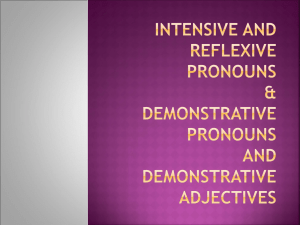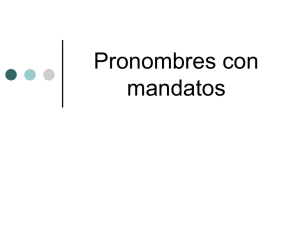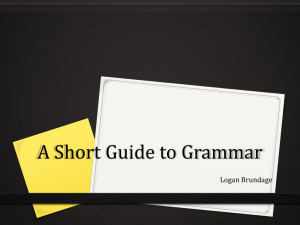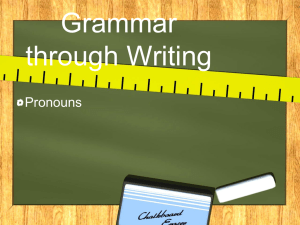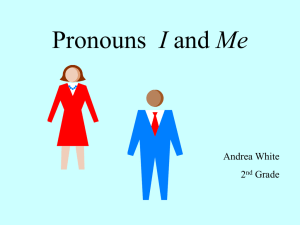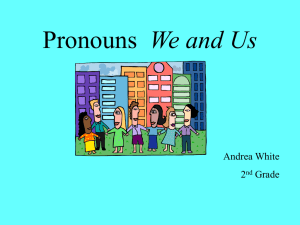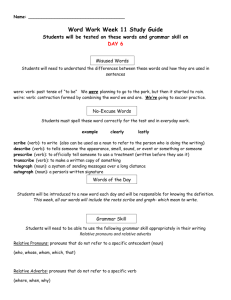Pronouns: Lesson 1: Regular Pronouns
advertisement
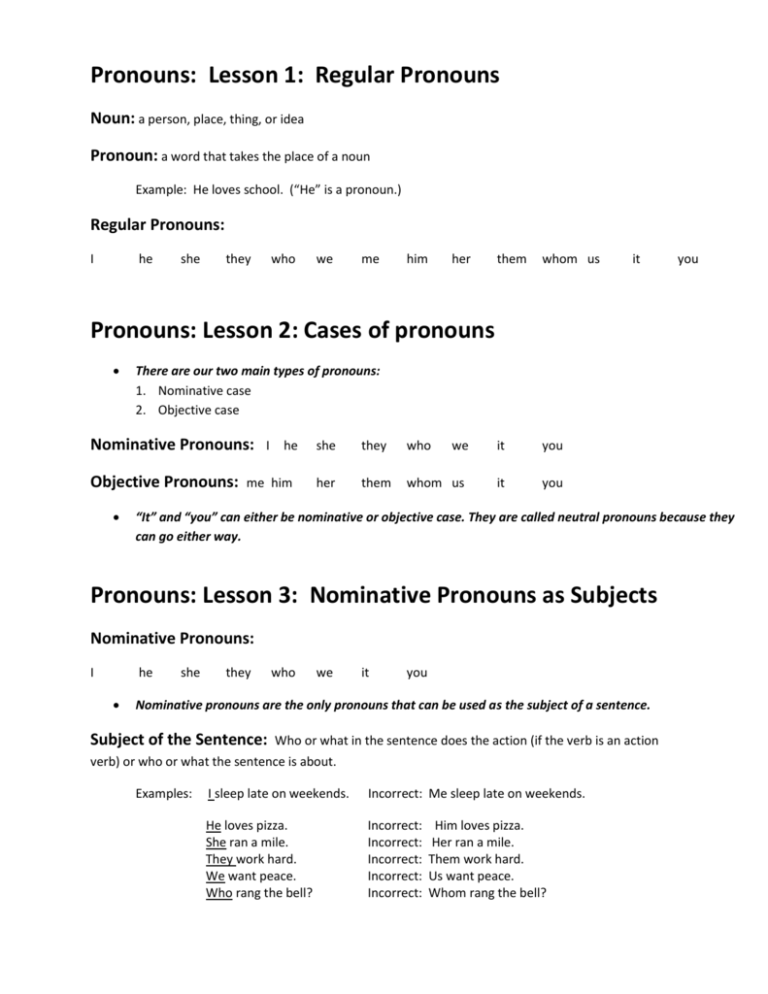
Pronouns: Lesson 1: Regular Pronouns Noun: a person, place, thing, or idea Pronoun: a word that takes the place of a noun Example: He loves school. (“He” is a pronoun.) Regular Pronouns: I he she they who we me him her them whom us it you it you it you Pronouns: Lesson 2: Cases of pronouns There are our two main types of pronouns: 1. Nominative case 2. Objective case Nominative Pronouns: Objective Pronouns: I he me him she they who we her them whom us “It” and “you” can either be nominative or objective case. They are called neutral pronouns because they can go either way. Pronouns: Lesson 3: Nominative Pronouns as Subjects Nominative Pronouns: I he she they who we it you Nominative pronouns are the only pronouns that can be used as the subject of a sentence. Subject of the Sentence: Who or what in the sentence does the action (if the verb is an action verb) or who or what the sentence is about. Examples: I sleep late on weekends. Incorrect: Me sleep late on weekends. He loves pizza. She ran a mile. They work hard. We want peace. Who rang the bell? Incorrect: Incorrect: Incorrect: Incorrect: Incorrect: Him loves pizza. Her ran a mile. Them work hard. Us want peace. Whom rang the bell? Be careful if there is a compound subject! Take out the subject that is not a pronoun and see if the sentence sounds right: Example: Me and my friends went to the store. -Take out “friends”: Me went to the store. (This sounds wrong!) Correct: My friends and I went to the store. Pronouns: Lesson 4: Pronouns as Predicate Nominatives Nominative Pronouns: I he she they who we it you Nominative pronouns are the only pronouns can be used as the predicate nominative of a sentence. Predicate Nominative (PN): 1. A noun or pronoun 2. It follows a linking verb 3. The predicate nominative can be switched with the subject of the sentence. Example: Mrs. Batsford became our teacher. (“teacher” = PN) -> switch: Our teacher became Mrs. Batsford. The winners were Ken and Bob. (“Ken, Bob” = PN) -> switch: Ken and Bob were the winners. Pronouns used as predicate nominatives: Examples: The winner was I Incorrect: The winner was me. It was he! Incorrect: It was him! The champion is she. Incorrect: The champion is her. The losers were they. Incorrect: The losers were them. To test which type of pronoun to use, switch the subject and the predicate nominative to see if it sounds right: Example: The winner was me. -> switch: Me was the winner. (This definitely sounds wrong!) Pronouns: Lesson 5: Objective Pronouns as Objects of the Preposition Objective Pronouns: me him her them whom us it you Objective pronouns are the only pronouns that can be objects of the preposition. Object of the Preposition-the nouns or pronouns that are at the end of a prepositional phrase. Example: after dinner (dinner=object of the preposition) Sometimes a prepositional phrase will have more than one object of the preposition: Example: with John and me (John, me = objects of the preposition) Pronouns: Lesson 6: Objective Pronouns as Direct Objects Objective Pronouns: me him her them whom us it you Objective pronouns are the only pronouns that can be Direct Objects. Direct Object (DO): a noun that receives the action of an action verb To find a direct object: 1. Find the action verb and say it aloud. 2. Then say “What?” 3. The word that answers your question is the direct object. Example: The boy kissed her. -“kissed” (find the action verb.) -Kissed what? (Say the action verb and ask “What?”) -“her” is the direct object (DO) A direct object will never be in a prepositional phrase. Examples of pronouns used as direct objects: Suzy hugged him. (Hugged whom? Him = direct object) Ashley likes whom? (Likes whom? Whom= direct object) Pronouns : Lesson 7: Pronouns Used as Indirect Objects Objective Pronouns: me him her them whom us it Objective pronouns are the only pronouns that can be indirect objects. you Direct Object (DO): a noun that receives the action of an action verb Indirect Object (IO): a noun that receives the direct object. Indirect Objects are only in sentences with direct objects. To Find an Indirect Object: 1. Find the direct object. If there is no direct object, then there won’t be an indirect object. 1. Say the action verb and the direct object and ask whichever one of these questions that fits: To whom?, To what?, For whom?, or For What? Example: I baked him a cake. Find the direct object- Baked what? – cake = DO Ask: Baked a cake for whom?- him = IO Examples of Pronouns Used as Indirect Objects: Suzy wished her luck. Wished luck to whom? her=IO Duane painted me a picture. Painted picture for whom? me=IO Be careful! Indirect objects are NEVER in prepositional phrases! Example: He painted for her a picture. “for her” is a prepositional phrase, so it is not an IO Pronouns: Lesson 8: Demonstrative Pronouns Demonstrative Pronouns: this that these those Demonstrative pronouns can be adjectives or pronouns depending on how they are used in a sentence. If a demonstrative pronoun is describing a noun, it is an adjective: Example: This line is crooked .(“this” is an adjective; it is describing the noun ”line”) This is crooked. (“This” is a pronoun; it is not describing anything.) Pronouns: Lesson 9: Indefinite Pronouns Indefinite pronouns: anyone anybody Some many nobody everyone several each any none either neither someone somebody Demonstrative pronouns can be adjectives or pronouns depending on how they are used in the sentence. If a demonstrative pronoun is describing a noun it is an adjective: Example: Some ducks waddled in the pond. (“Some” is an adjective; it is describing the noun ”ducks”) Some waddled in the pond. (“Some” is a pronoun; it is not describing anything.)

